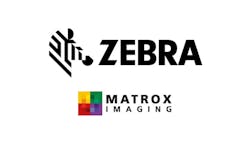Zebra Technologies to Acquire Matrox Imaging
On March 15, 2022, Zebra Technologies announced its intent to acquire Matrox Imaging, a provider of platform-independent software, software development kits (SDKs), smart cameras, 3D sensors, vision controllers, input/output (I/O) cards, and frame grabbers that are used to capture, inspect, assess, and record data from industrial vision systems in factory automation, electronics and pharmaceutical packaging, semiconductor inspection, and more.
Zebra entered the machine vision market in 2021 with its acquisition of Adaptive Vision and Fetch Robotics. Acquiring Matrox Imaging is in line with its strategy to continue growing in the machine vision space. “If you look at what we’ve done internally, we’ve come up with a family of smart cameras and industrial scanners particularly focused on the entry level of the market,” says Donato Montanari, Vice President and General Manager, Machine Vision, Zebra Technologies. “Our software is very intuitive, is very easy to use, and is purposefully not meant for machine vision experts. With the Adaptive acquisition last year, we expanded our software capabilities to cover a higher part of the machine vision market. We recognize that in machine vision, software is the key, and we wanted to bring that talent inside of Zebra. Now with Matrox Imaging, we are expanding it. Not just on the software side. MIL and Design Assistant are very strong brands, particularly for the expert machine vision users but also complementary in terms of other hardware platforms. If you look at our smart cameras, we are focused more on the lower resolutions whereas Matrox is more focused on the high resolutions, and they also have 3D sensors, PC-based machine vision, and frame grabbers.”
Sam Lopez, Senior Vice President, Sales & Marketing, Matrox Imaging, adds, “They’ve entered the machine vision market with entry level machine vision solutions. We have focused traditionally on the mid to high-end side of the business. For us, it was always important to have both hardware and software. We’ve never shied away from challenges in terms of developing bleeding edge hardware and software. And, I think that’s what we’re bringing. When you join the two, essentially you get the perfect piece.”
Zebra expects the Matrox Imaging acquisition to expand its portfolio of machine vision products, software, and services it can offer customers to help them thrive in the on-demand economy that is constrained by both labor shortages and limited supply of upstream goods and materials. In addition, Zebra values the employees of Matrox Imaging and what they bring to the table. “One of the main reasons we are doing this acquisition is we recognize that the talent pool Matrox Imaging has in its organization is outstanding,” says Montanari. “They are veterans of this industry. They’ve been around for a very long time.”
Related
- Zebra Technologies Acquires Adaptive Vision
- Zebra Technologies Releases Smart Camera and Industrial Scanner Product Lines
- Event-Logging Tool for Frame Grabbers
Lopez adds that the acquisition will allow Matrox Vision to accelerate its development in different areas. “We’ve been investing heavily in 3D technologies and machine learning/deep learning/AI technologies,” he says. “These are very complex, very advanced technologies that require a huge investment to not only continue but to advance them to where we want to go. What Zebra brings to us are the resources, the capabilities, and the additional investments that are going to be required to accelerate all of this. There are many things that we have on the drawing board that we haven’t been able to get around to yet because we’re limited in terms of our resources.”
Zebra also expects to benefit from the variety of synergies between each company’s products and employees. “This is really one of the reasons we are looking forward to this acquisition: the people,” says Montanari. “We have talked about the complementary portfolios. If we talk about the people specifically, I think there is also a very complementary nature in the skillsets we have. Matrox Imaging folks are really on the high end, and we are on the low end.” Montanari cites the combination of traditional machine vision and deep learning as one example of complementary skillsets. “We, as a machine business unit, already have a software development center in Canada, and we have people there who are experts specifically in the area of deep learning,” he says. “There’s nothing better than combining traditional machine vision with deep learning. But, it’s really a combination of the two. We’ve learned that the hard way. Deep learning by itself doesn’t work very well if you don’t do any preprocessing or post processing. So, you’ll see a lot of synergies with the way we go to market. You’ll see lots of accelerations in terms of new products coming out, new families being expanded at both ends. We at Zebra can help with deep learning, and Matrox can help with traditional algorithms.
Zebra began its foray into the machine vision space just a year ago. However, 94% of Fortune 100 customers are already Zebra customers. Zebra provides a foot in the door for Matrox Imaging to these companies, which has already occurred for Adaptive Vision. And, it expects its growth in machine vision to continue. “In our very short venture into machine vision, we have very clear ideas. We’ve studied the market for a while. I think we demonstrated that we can add products and portfolios organically, developing them in Zebra like we do with our smart cameras, and via acquisitions. We will continue to develop organically and we will continue to look at inorganic expansion. It depends on what the market offers. That said, what we have internally, in addition to Adaptive and Matrox Imaging, is quite decent fire power. You will see a lot of products coming out of this combined entity in the near future and in the long term.”
About the Author
Chris Mc Loone
Editor in Chief
Former Editor in Chief Chris Mc Loone joined the Vision Systems Design team as editor in chief in 2021. Chris has been in B2B media for over 25 years. During his tenure at VSD, he covered machine vision and imaging from numerous angles, including application stories, technology trends, industry news, market updates, and new products.

